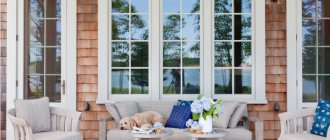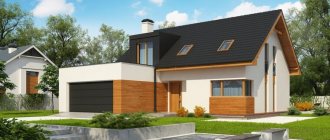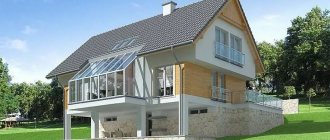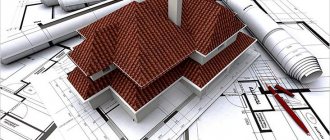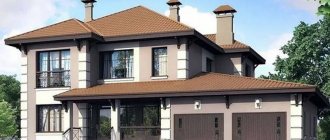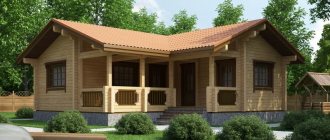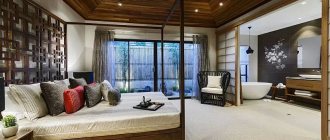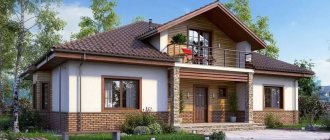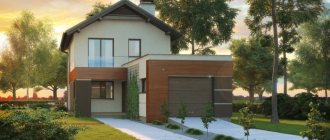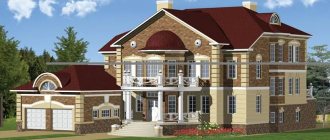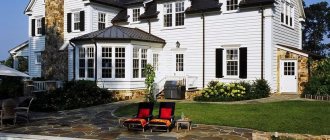Single-family homes are great for many reasons. One of them is the opportunity to provide additional comfort for the family in advance, at the project stage. This is done in different ways: they add a garage and an attic, erect a gazebo in the garden, build a bathhouse. And it’s rare that an owner will refuse such an architectural element as a veranda or terrace.
The suburban area is increasingly perceived as a place of relaxation and enjoyment of nature, and not of labor feat. Both extensions create comfortable conditions for a good rest; they determine the appearance of the facade, giving it an individual style. A house with a veranda or terrace is much more convenient for those who like to host family dinners or friendly parties.
Civilized relaxation with comfort Source dom-steny.ru
Veranda and terrace: differences
Projects of one-story and two-story houses can contain both a veranda and a terrace, together or separately. The buildings have a fundamental difference:
- Terrace. Open area; it is often done on a foundation (monolithic or raised on stilts). It can be adjacent to the wall of the house; sometimes it is located on the second floor or on a flat roof. The appearance of a terrace is often determined by local climatic conditions. In the south, this is an open area, often with railings or vegetable fencing. In the middle zone, terraces are equipped with a roof or awning.
- Veranda. Essentially this is an enclosed terrace. It is adjacent to the house with one or two walls, has a roof and is an enclosed space (most often without heating). They try to glaze it to increase it visually and let in more light.
Selecting a project: veranda or terrace
Professional builders advise making a choice at the development stage of an architectural project, before materials are determined and estimates are calculated. Subsequent changes will mean additional costs of time and money. It is better to choose a project with a terrace if:
- The house is being built in a region with hot summers, early springs and long, warm autumns.
- The size of the land plot allows you to comfortably arrange a terrace without crowding out other areas.
You can be outside the walls and feel the comfort of home Source decoratedlife.com
- The house does not need additional usable space.
- The family loves spending time outdoors.
A veranda is best for you if:
- The place where the housing will be built is a region with snowy, frosty winters, prolonged autumn rains and cool, windy summers.
- The plot is of modest size; the land can be used more rationally.
- An additional indoor space is a necessary increase in the area of the house.
- You need a multifunctional space where you can not only relax, but also store things, supplies and equipment.
Houses with a terrace: design features
The main thing for which a country house is valued is the opportunity to spend a lot of time outdoors. Projects of houses with a terrace allow you to realize this desire with maximum comfort. The advantages of such buildings are:
- Low construction cost.
- Expanding the space of the house. In warm weather, they set up a summer kitchen here, receive guests, sunbathe and sleep.
- Order. It is easier to maintain cleanliness in your home by leaving your work clothes and changing shoes on the terrace.
Summer lunch outdoors in a house with a terrace Source houzz.com
Project specifics
Designing a house with a terrace has its own characteristics:
- The foundation of the house and terrace can be common or built separately. The height of the structure is calculated so that it remains dry.
- They try to place the terrace on the south side of the house. This is especially convenient in the middle zone, where the canopy is often removable. If the terrace will be used more often in the afternoon, it would be more logical to make it facing west.
- The extension is positioned so that it offers a picturesque view of the surrounding landscapes or the designer beauty of the site.
- If the roofing material of a building is too heavy for a terrace roof, it is replaced with a lighter one, while maintaining the overall style.
Arrangement options
The open terrace is perceived as a link between the enclosed space of the house and nature; most often it is located at the entrance. Such buildings fit harmoniously into the surrounding landscape and look attractive from the point of view of design possibilities:
- Fencing. It can be decorative or protective. In the first case, the fence is low and graceful; Often flowers or ornamental shrubs are planted around the perimeter. Pergolas (canopies formed by several arches) decorated with climbing plants or bright flowers in pots look good as a fence. If the decking of the terrace is located high (from 0.5 to 1 m), reliable fencing with railings is necessary.
A winning option is to decorate a house project with a terrace with ornamental plants Source decordezine.com
- Roof. The stationary roof can be replaced with a removable awning, retractable awnings or a portable umbrella.
- The terrace is separated from the house. In this case, they are connected by a path; the path can be decorated with lighting (looks beautiful in the evening), one or several openwork arches, creating the effect of a tunnel.
- Attic with terrace. The attic, which has access to the terrace, is an ideal place for morning (or evening) tea, watching birds, children and neighbors.
- House with a high base. An interesting option would be a terrace on a columnar foundation surrounding the building. Supplemented with a roof, it can become a comfortable and spacious place to relax.
Materials for building a terrace
For the construction of country terraces, all kinds of materials are used; the most common buildings are:
- Wooden terrace. The leaders in terrace construction are wooden terraces. They contain a lot of advantages: quick construction, low financial costs, versatility of execution and the aesthetics of natural wood. Subsequent care can become difficult - in order to protect the tree from the destructive effects of penetrating moisture, it must be regularly treated with impregnation based on oil and antiseptic.
Two-level wooden terrace Source qpdecor.vn
See also: Catalog of projects of houses with a veranda and terrace presented at the exhibition “Low-Rise Country”.
- In defense of terraces made of brick and slab concrete, it can be said that they are more practical, but require a foundation. Terraces located on the ground are covered with one of the most reliable materials - clinker (high-strength ceramic tiles). On a raised structure, both clinker and ordinary paving slabs are used.
- Stone terrace. It looks stylish and also needs a solid foundation. A stone with low water absorption (up to 3-5%) is suitable for an open terrace. Optimal rocks are shales, granite and basalt. Sandstone or limestone can be used on roofed buildings.
Material for construction
The raw materials for the production of laminated veneer lumber are the following types of wood:
- Pine. All coniferous tree species are universal raw materials for the production of laminated veneer lumber, but pine is the leading material. It is strong and durable, has a pleasant color with a yellowish tint, an original texture and an attractive pattern. The density of pine is 520 kg/m3.
- Cedar. It is distinguished by its pale yellow wood color with a white and pink core. The texture of cedar is much softer, it is uniform, but there are many small knots, the density is 420 kg/m3. The finished cedar timber has a pleasant aroma and also has an antimicrobial effect. Cedar timber is less susceptible to rotting, cracking, and shrinkage. Therefore, such timber is suitable for any construction. Cedar wood tolerates treatment with various substances.
- Larch. It can have different shades from white-yellow to white-red. This type of wood has an amazing patterned texture; its density is equal to oak and is 580 kg/m3. Larch tolerates treatment with coloring mixtures; any structures can be built from it, including terraces. Another advantage is high resistance to rotting. This wood can be identified by its unique turpentine smell and the presence of growth rings on all cuts.
- Spruce. This wood is recognized by its light yellowish tint and smooth texture with many small, chaotically scattered knots. Compared to other types of wood, spruce has a low density of 430 kg/m3. This is a lightweight, easy-to-work material that can withstand processing and painting. Spruce timber is suitable for a wide variety of designs, as well as for the manufacture of finishing materials.
The environmental friendliness of laminated veneer lumber depends on the adhesive mixtures. Polyurethane, melamine or isocytate adhesives are often used. Melamine glue is the worst of all, as it contains dangerous formaldehydes.
None of these adhesives interfere with natural vapor and gas permeation. Also, the strength characteristics of the timber do not depend on the choice of glue.
Houses with a veranda: design features
In countries with warm climates, the veranda traditionally serves as a place to relax. In our penates, the possibilities of their use have expanded; Several types of verandas have become widespread, which can be classified:
- By type of construction. Verandas are designed attached and free-standing.
- By type of foundation. It can be separate or be part of a permanent structure.
- By type of use. The veranda can be fully used in winter, for which it will have to be glazed and heated.
The advantages of a project with a veranda include:
- Possibility of increasing the living space (after insulating the walls) without a significant increase in cost.
- An additional room protects the house from heat loss during the cold season.
Photo of a country house with an attic and a veranda - a practical and cozy place to relax Source pobudova.in.ua
See also: Catalog of companies that specialize in designing country houses.
Features of veranda design
Customers often decide to build a house with a veranda under one roof, the design of which is subsequently adjusted. When designing, pay attention to:
- Location. A veranda is built into a building or attached to it. As with the terrace, the view from the inside is important for this design. A veranda facing the street is not the best option.
- Usage. If the house has a small area, the veranda can simultaneously serve as a hallway, dining room and relaxation area. In some projects there is a staircase to the second floor.
- Convenience. The veranda should be adjacent to the wall in which the front door is located, or connected to the kitchen.
- Glazing. May be permanent or seasonal. Window elements are most often placed around the entire perimeter. For panoramic glazing, ordinary window blocks and double-glazed windows (with both plastic and wooden profiles) are used. The veranda with a large glass area provides excellent internal insolation (sunlight). To protect from sunlight, curtains, blinds, shutters and screens are used.
Panoramic glazing allows you to enjoy a sunny day Source houzz.jp
Arrangement options
- Various designs of houses with a veranda are in demand on the market. Both verandas adjacent to the facade and those encircling the building are popular. The shape can be rectangular, square, with rounded corners.
- If the design of a house with a veranda includes a balcony on the second floor, a veranda that follows its shape looks best.
The fireplace creates a feeling of tradition and reliability Source houzz.com
Materials for constructing a veranda
When choosing a material for a veranda, they base it on its role: if the extension is intended to be used year-round, it will have to not only be glazed, but also insulated, and heating must be considered. The material of the veranda should be in harmony with the house; if it is wooden, then wood is used for the veranda. Meet:
- Veranda made of brick (stone, foam block). The most durable option. A heavy extension requires a solid foundation, the same as under the house. This will protect the veranda from destruction.
- Veranda made of wood (timber or logs). It has the special charm inherent in natural wood and provides an excellent microclimate. It is decorated with carved panels and elements.
Professional approach
is engaged in the construction of comfortable country wooden houses of various sizes and number of storeys from building materials of its own production. A house project made of pine, larch, cedar can have an area of up to 150 m² and more than 500 m². For the manufacture of the structure, chopped or rounded logs, glued or profiled beams are used.
The cost of construction for finished projects remains fixed, without additional investments and changes during the course of work. Buying a comfortable country house according to a standard project is a more profitable investment. Clients have the opportunity to order an individual wooden house project, which takes into account all the wishes and requirements of the customer.
